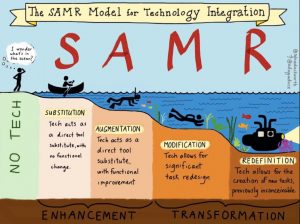Shulman talks about PCK or Pedagogical Content Knowledge and the intersection of these areas and the how it is a “special amalgam of content and pedagogy that is uniquely the province of teachers, their own special form of professional understanding.” (Shulman, 1987) PCK represents the “blending of content and pedagogy into an understanding of how particular topics, problems, or issues are organized, represented, and adapted to the diverse interests and abilities of learners, and presented for instruction.” (Shulman, 1987). In his paper he provides a framework to observe teacher instruction and what is needed to create a knowledge base for teachers. He identifies that it is much more than knowing the content or knowing how but the connection of the two that creates superior lessons.
Mishra and Koehler (2006) extend Shulman’s work with the addition of T to PCK which incorporates technology into the framework. “TPCK is the basis of good teaching with technology and requires an understanding of the representation of concepts using technologies; pedagogical techniques that use technologies in constructive ways to teach content; knowledge of what makes concepts difficult or easy to learn and how technology can help redress some of the problems that students face; knowledge of students’ prior knowledge and theories of epistemology; and knowledge of how technologies can be used to build on existing knowledge and to develop new epistemologies or strengthen old ones.” (Mishra & Koehler, 2006, Pg. 1029) They aim to extend Shulman’s work with a framework that supports effective integration of technology into today’s classrooms as well as an idea of how to support teachers learning around developing lessons that maximize the interaction of these TPCK elements.
An example for me around TPCK would be the work that I have done this year with coding. We have been started with hour of code, which is a sequenced program that teaches the basics of coding. From there we moved into Scratch and went through a list of tasks designed to build awareness of the different aspects of coding. Finally students created a story or an inquiry question, generally related to a topic of study this year, and created a game to either tell the story or support a student learning the knowledge from the inquiry question. The result was better than I could have imagined and feels like I discovered the spot in the middle that Mishra and Koehler describe where pedagogy, technology and content mix perfectly. Students have truly had a multidisciplinary approach as they used math to solve movement issues, design skills as they tried, failed, and tried again to make their games work, and much more. Pedagogically as each student worked through the process with their own design using an inquiry lens they were definitely captivated and motivated to preserve through the tough time. As we get ready to take our games to student arcade I am excited for them to be able to show off their learning.
References:
Mishra, P., & Koehler, M. (2006). Technological pedagogical content knowledge: A framework for teacher knowledge. The Teachers College Record, 108(6), 1017-1054.
Shulman, L.S. (1987). Knowledge and teaching. The foundations of a new reform. Harvard Educational Review, 57(1)1-23.
